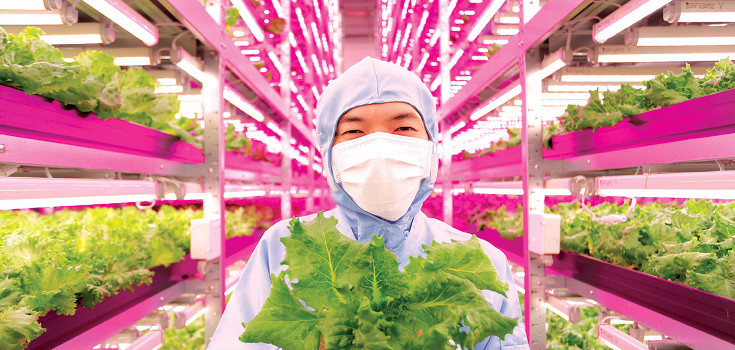Japan’s Answer to Radiation: Massive Natural Indoor Farms

Can earthquakes and tsunamis put the Japanese food producer down? Apparently not. Sanriku Fukko National Park now hosts the world’s largest indoor farm. It was built inside an old, 25,000-square-foot semiconductor factory and uses 100 times less water than an outdoor farm. What’s more, they claim that their produce contains 8 to 10 times more beta-carotene and twice the vitamin C, calcium and magnesium as its outdoor-grown counterparts.
The produce grown at this weather-resistant, climate controlled plant uses LED lights and can yield over 10,000 heads of lettuce per day! With examples like this it is easy to see why indoor gardening or urban green-housing is expected to grow from a $30 million to a $270 million industry by 2020.
With solar power, the cost to produce organic, non-GMO foods could be lowered even more. This trend is also likely part of a new high-tech, non-GMO, organic farming model that is more sustainable, and can ensure food sustainability in even the most climate-challenged locales.
Another Japanese farm is located in the basement of a high-rise building in Tokyo. It uses hydroponics to grow a variety of flowers all year long.
The Japanese government plans to promote indoor gardening as a way to create jobs and aid in food security. Officials will offer incentives including low-interest financing and a capital investment tax credit. About 40 indoor growing facilities are already in operation nationwide.
More than 150 national disasters have struck Japan in the last 30 years, largely due to their position over tectonic plates. The Fukushima incident is just the latest, and most egregious tragedy. But other places in the world have witnessed challenging if not equally devastating occurrences that threaten their food supply.
Read: Paper Argues Against Factory Farms ‘Feeding the World’
California has experienced the worst single-year drought in all of history, affecting the production of fruits and vegetables not just within the state, but across the US. Colorado and Texas have faced similar droughts but they are not responsible for growing 68% or more of all produce for the entire country.
What’s more, Africa has seen no improvements in food shortages in the cultivation of GMOs, even with the promises of biotech.
India once cultivated farms that yielded incredible grains and legumes that were full of nutrients, but reports are that food shortages loom there as well.
Water conservation, lowered costs, immunity to weather patterns, and the ability to grow all manner of food from micro-greens to bananas without chemical pesticides and fertilizers are all boons to the growing indoor farming model.

Suggest you obtain outside pictures of these indoor farms to comprehend just how big they really are.
The Dome by Stephen King is not sci fi its here and now. Communities across the globe need to be organizing and gathering for our coming harvests Organic seeds,soil and water will be the new gold and oil.
if you tried this in the USA you would be hauled off to jail by insane EPA nuts…
Way to go. I read somewhere the US Midwest started to do indoor fish farming.
They never tell the cost of the materials needed and the cost of the energy.
I bet it costs $6 per carrot.